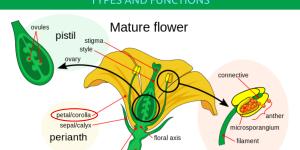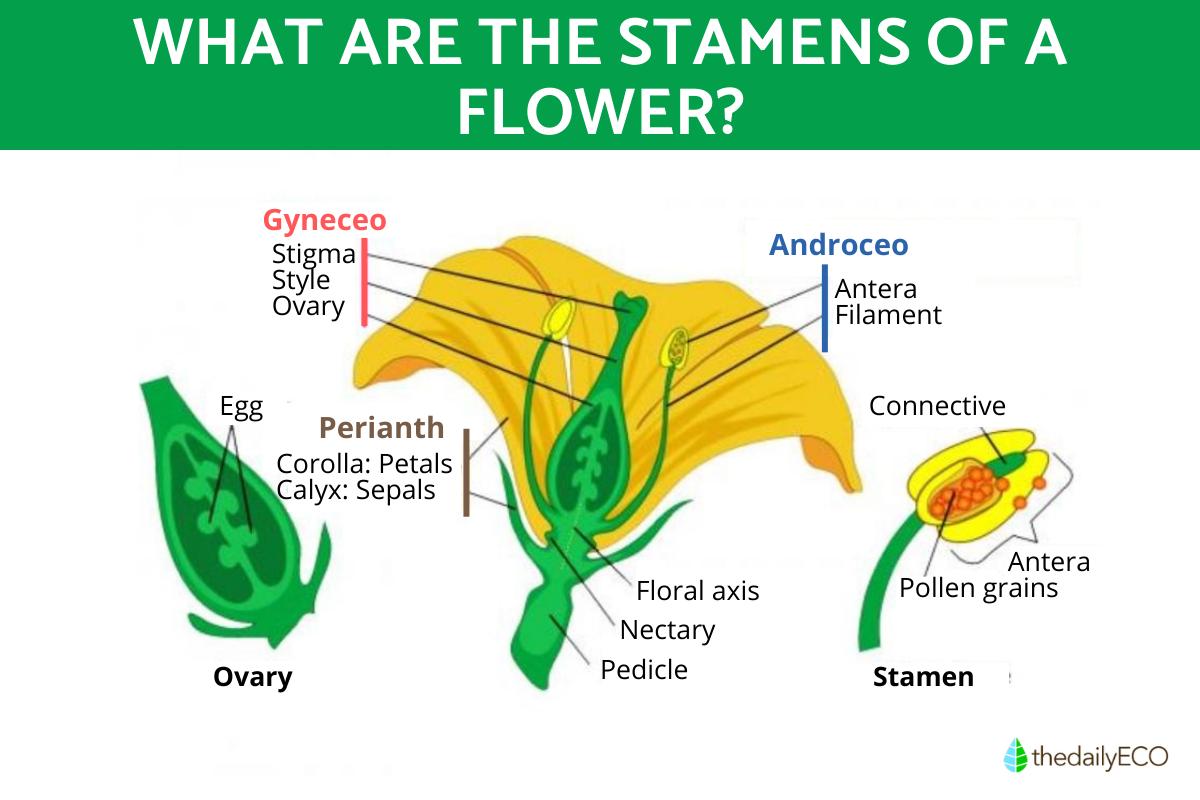What Are the Stamens of a Flower?


Flowers are the vibrant crowns of the plant kingdom, captivating us with their diverse shapes, sizes, and colors. However, they serve a vital purpose that goes beyond aesthetics: reproduction. These magnificent exhibitions are nature's intricate factories, producing seeds for the following generation. To achieve this goal, flowers possess a remarkable array of specialized structures. One such key player, from the plant's "male perspective," is the stamen.
This article by thedailyECO dives deeper into the world of stamens, exploring their various types, functions, and the critical role they play in flower reproduction.
What are the stamens inside the flower?
At the heart of a flower lies the stamen, the plant's male reproductive organ. This slender stalk, often elongated, proudly displays the anther, a pollen-producing sac. Together, stamens form the androecium, a vital component of the plant's masculine machinery.
The stamen itself is a duet of two parts: the filament, a thin stalk that acts as a sturdy support, and the anther, the star of the show.
Packed within the anther are pollen sacs, responsible for creating the tiny pollen grains needed for reproduction. Interestingly, the way the anther connects to the filament varies between plant families, adding a touch of diversity to this crucial structure. Most anthers house no more than four pollen sacs, each brimming with the potential for new life.
When a flower blooms, the anthers release pollen grains, which can then be carried by wind or pollinators to the female reproductive organ of another flower (the pistil). If pollination is successful, the pollen grains will fertilize the ovules in the pistil, which will then develop into seeds.
Pollination isn't a solo act! Learn how carpels complete the cycle in this other article.

What is the role of the stamen in the flower?
Stamens are essential for the reproduction of flowering plants, as they produce and contain pollen—the genetic material of a plant.
Their main function is to ensure the production, storage, and transportation of pollen to the ovary of a female flower, facilitating seed formation.
Stamens also play a crucial role in attracting pollinating organisms, often through visually striking features akin to flower petals, or by having the stamen itself be brightly colored.
Additionally, some stamens produce nectar, a sugary liquid rich in nutrients, to further entice pollinators and enhance the success of flower pollination.
Interestingly, stamen structure can vary among flowering plants, with some sporting long filaments that hold the pollen-laden anther high above the petals. Once mature, pollen is released from the anther through tiny pores or splits, ready to hitch a ride on a pollinator or be carried by the wind.
Here's a breakdown of the process:
- Pollen production: inside the stamen's sac-like structure called the **anther**, pollen grains are manufactured through cell division.
- Pollen release: once mature, the pollen grains are released from the anther, often bursting open or splitting seams.
- Pollination: these pollen grains then need to reach the female reproductive part of the flower (pistil) for fertilization to occur. This can happen through wind dispersal or by hitching a ride on pollinators like insects or animals.
Curious about where the magic of fertilization happens in a flower? Unravel the mystery of the gynoecium in our related article.
Types of flower stamens
Stamens come in all shapes and sizes and this variety helps scientists identify different plant families. Variations in stamen structure can prevent successful cross-pollination between closely related species, leading to the formation of new ones over time. Here are some of the main types:
Connate stamens
Connate stamens represent a distinct category within stamen morphology, characterized by the fusion of individual filaments. These filaments, the slender stalks supporting the pollen sacs (anthers), merge to create unique structures that play a crucial role in plant reproduction. Let's explore the various subtypes within connate stamens:
- Single bundle: all the filaments in a Monadelphous stamen combine to form a single tube-like structure surrounding the pistil (the female reproductive part) in the center of the flower. This type of stamen fusion is commonly seen in the Myrtaceae family, which includes plants like Eucalyptus and Bottlebrush.
- Two bundles: in Diadelphous stamens, the filaments fuse into two separate bundles, often with one bundle containing more stamens than the other. This arrangement might be linked to attracting specific pollinators. This arrangement might be linked to attracting specific pollinators.hese are commonly found in the Fabaceae family, which includes familiar plants like peas, beans, and lentils.
- Three or more bundles: Polyadelphous stamens are formed by the union of filaments into three or more distinct bundles. This configuration might enhance pollen accessibility for pollinators. Citrus plants like oranges and lemons showcase this type of stamen fusion.
- Fused anthers: here, the anthers (pollen sacs) are attached to each other, forming a single ring-like structure around the pistil. This unique arrangement might play a role in pollen dispersal. Synantherous stamens are a defining feature of the Asteraceae family, which includes sunflowers, daisies, and asters.
Adnate stamens
Unlike connate stamens where filaments fuse with each other, adnate stamens exhibit a fusion between the filaments and other floral parts. This intricate arrangement can influence aspects like pollen presentation and pollinator interaction. Let's delve deeper into the fascinating subtypes of adnate stamens:
- Epipetal stamens:in epipetal stamens, the filaments become intimately associated with the corolla, the colorful petals of the flower. This fusion isn't just a physical connection; it can have functional implications. This positioning might influence the placement of the anthers for more efficient pollen transfer to pollinators. For instance, in some primroses, the corolla tube formed by the fusion might guide pollinators towards the reproductive organs. Epipetal stamens are found in a wide variety of flowering plant families, including Primulaceae (primroses) and Ericaceae (heaths and blueberries).
- Didynamous stamens: didynamous stamens exhibit four stamens in total, arising in two distinct pairs from the flower base. Notably, one pair is typically longer than the other. This variation in stamen length might promote contact with different pollinators depending on their body size. For example, in some mint flowers, the longer stamens might brush against the back of a bee, depositing pollen on its fur, while the shorter stamens might ensure pollen transfer to smaller pollinators. This type of stamen configuration is characteristic of some members of the Lamiaceae family (mints) and Scrophulariaceae family (snapdragons).
- Tetradynamous stamens: this unique configuration involves six stamens, with four developing at a longer length compared to the remaining two. This variation in stamen length might contribute to the flower's visual display, potentially attracting pollinators seeking nectar or pollen rewards. The contrasting stamen lengths could also create a landing platform for pollinators, facilitating pollen transfer. Tetradynamous stamens are a defining feature of the Brassicaceae family (mustard family), which includes plants like cabbage, broccoli, and cauliflower.

Other stamen variations
- Some stamens have long stems, while others are short. Long filaments can position pollen grains above flower petals, making them more accessible to pollinators.
- The position of the pollen sacs on the stem can vary.
- Stamens open in different ways to release pollen.
Stamen diversity isn't just about variety but survival. Plants have evolved these adaptations in stamen structure to improve their reproductive success. For example, stamens might be brightly colored or produce nectar to attract specific pollinators like bees or butterflies. In some flowers, stamen structure helps guide pollinators towards specific areas on the pistil for efficient fertilization.
Flowers aren't just about the colorful petals. Dive deeper into the fascinating structure surrounding the stamen in our article on the flower's protective envelope.
If you want to read similar articles to What Are the Stamens of a Flower?, we recommend you visit our Biology category.







